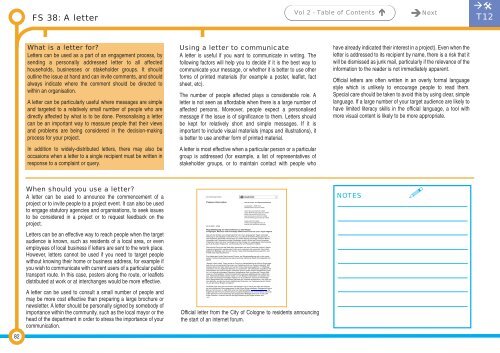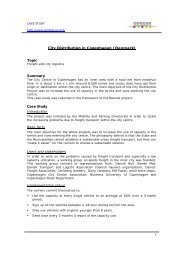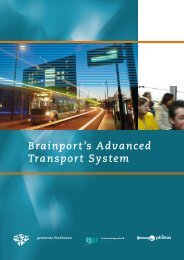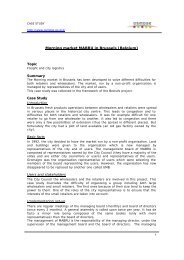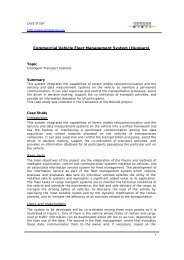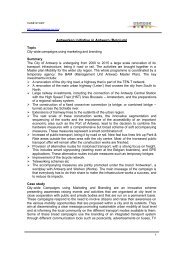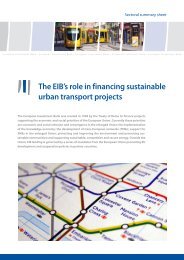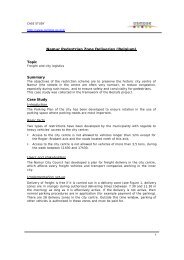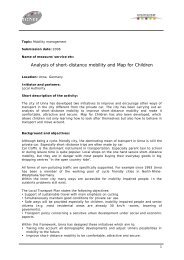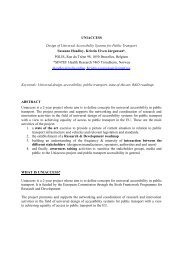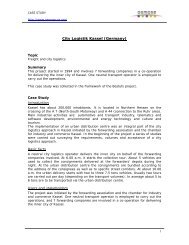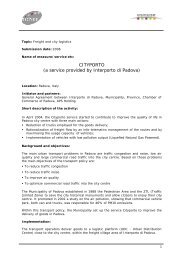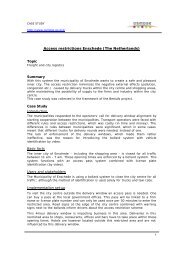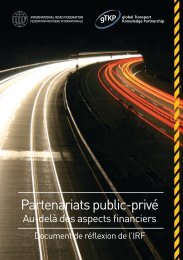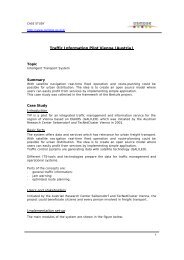Successful transport decision-making - Osmose
Successful transport decision-making - Osmose
Successful transport decision-making - Osmose
You also want an ePaper? Increase the reach of your titles
YUMPU automatically turns print PDFs into web optimized ePapers that Google loves.
FS 38: A letter<br />
Vol 2 - Table of Contents <br />
Next<br />
<br />
T12<br />
What is a letter for?<br />
Letters can be used as a part of an engagement process, by<br />
sending a personally addressed letter to all affected<br />
households, businesses or stakeholder groups. It should<br />
outline the issue at hand and can invite comments, and should<br />
always indicate where the comment should be directed to<br />
within an organisation.<br />
A letter can be particularly useful where messages are simple<br />
and targeted to a relatively small number of people who are<br />
directly affected by what is to be done. Personalising a letter<br />
can be an important way to reassure people that their views<br />
and problems are being considered in the <strong>decision</strong>-<strong>making</strong><br />
process for your project.<br />
In addition to widely-distributed letters, there may also be<br />
occasions when a letter to a single recipient must be written in<br />
response to a complaint or query.<br />
Using a letter to communicate<br />
A letter is useful if you want to communicate in writing. The<br />
following factors will help you to decide if it is the best way to<br />
communicate your message, or whether it is better to use other<br />
forms of printed materials (for example a poster, leaflet, fact<br />
sheet, etc).<br />
The number of people affected plays a considerable role. A<br />
letter is not seen as affordable when there is a large number of<br />
affected persons. Moreover, people expect a personalised<br />
message if the issue is of significance to them. Letters should<br />
be kept for relatively short and simple messages. If it is<br />
important to include visual materials (maps and illustrations), it<br />
is better to use another form of printed material.<br />
A letter is most effective when a particular person or a particular<br />
group is addressed (for example, a list of representatives of<br />
stakeholder groups, or to maintain contact with people who<br />
have already indicated their interest in a project). Even when the<br />
letter is addressed to its recipient by name, there is a risk that it<br />
will be dismissed as junk mail, particularly if the relevance of the<br />
information to the reader is not immediately apparent.<br />
Official letters are often written in an overly formal language<br />
style which is unlikely to encourage people to read them.<br />
Special care should be taken to avoid this by using clear, simple<br />
language. If a large number of your target audience are likely to<br />
have limited literacy skills in the official language, a tool with<br />
more visual content is likely to be more appropriate.<br />
When should you use a letter?<br />
A letter can be used to announce the commencement of a<br />
project or to invite people to a project event. It can also be used<br />
to engage statutory agencies and organisations, to seek issues<br />
to be considered in a project or to request feedback on the<br />
project.<br />
Presse-Information<br />
Amt für Presse- und Öffentlichkeitsarbeit<br />
Laurenzplatz 4, 50667 Köln<br />
Redaktionsbüro 0221/221-26456<br />
Ulrich Höver (hö) 0221/221-26487<br />
Jürgen Müllenberg (jm) 0221/221-26488<br />
Stefan Palm (pal) 0221/221-22144<br />
Inge Schürmann (is) 0221/221-26489<br />
Simone Winkelhog (sw) 0221/221-26785<br />
Telefax 0221/221-26486<br />
E-Mail presseamt@stadt-koeln.de<br />
Internet www.stadt-koeln.de/presse<br />
24.03.2004 - 0308<br />
Rege Beteiligung am Internet-Forum zu den Ringen<br />
Anregungen, Wünsche und Vorschläge elektronisch noch bis zum 3. April möglich<br />
Das Amt für Straßen und Verkehrstechnik hat in den vergangenen Tagen nochmals<br />
Werbung für das städtische Internet-Forum zur Zukunft der Kölner Ringe gemacht. An<br />
alle Haushalte, Geschäfte, Restaurants und Cafés entlang der Ringe zwischen Barbarossaplatz<br />
und Friesenplatz wurden Postkarten verteilt, die auf das Forum hinweisen.<br />
Postkarten haben bei einer Verteilaktion auf den Ringen am vergangenen Wochenende<br />
auch die Kunden, Restaurant- und Kinobesucher und Passanten erhalten.<br />
Das Internet-Forum hat die Stadt Köln gemeinsam mit dem Fraunhofer Institut in Sankt<br />
Augustin eingerichtet, welches das Forum auch moderiert und auswertet. Das Institut<br />
gliedert die Beiträge nach Art und Themen, fasst Zwischenergebnisse zusammen und<br />
erstellt einen Abschlussbericht.<br />
Zum bisherigen Verlauf des Internet-Forums, zur Bürgerbeteiligung und zu den registrierten<br />
Themenschwerpunkten hat das Fraunhofer Institut der Stadt Köln folgendes mitgeteilt:<br />
„Bereits in den ersten Tagen wurde im Forum zur Neugestaltung der Kölner Ringe angeregt<br />
über die momentanen Planungen zur Gestaltung und zum Verkehr diskutiert. Mittlerweile<br />
(Stand 22. März 2004) sind auf der Online-Diskussionsplattform 113 Beiträge<br />
erschienen und 72 registrierte Benutzer zu verzeichnen. Die zahlreichen Zugriffe auf die<br />
Internetseiten des Forums deuten zusätzlich auf eine große Anzahl interessierter Leser<br />
hin. Im Laufe der bisherigen Diskussion kristallisieren sich vor allem die Themen Radwege<br />
und Fahrradfahrer, Verkehr/Verkehrsführung sowie städtebauliches Leitbild heraus.<br />
Interessenskonflikte werden dabei von den Bürgern thematisiert und darüber hinaus<br />
auch mit Lösungsvorschlägen ergänzt. Es ist zu betonen, dass sich die Beiträge<br />
durch Sachlichkeit und persönliches Interesse der Verfasser auszeichnen, was nicht nur<br />
eine lebhafte, sondern auch eine zielführende Diskussion zur Verbesserung der Situation<br />
auf den Kölner Ringen ermöglicht.“<br />
Die Stadt hofft, dass sich noch mehr Interessierte von zu Hause aus über das Internet<br />
an dem städtischen Planungsprozess für die Kölner Ringe beteiligen. Gelegenheit hierzu<br />
gibt es noch bis zum 3. April 2004 unter der Internetadresse www.stadt-koeln.de/ringe. Die<br />
Ergebnisse des Forums werden danach zusammengefasst und in einer Bilanz online abrufbar<br />
gemacht. Eine Auswertung der eingereichten Beiträge geht auch an die politischen<br />
Gremien, in denen über die künftige Gestaltung der Ringe beraten wird.<br />
- jm –<br />
NOTES<br />
<br />
Letters can be an effective way to reach people when the target<br />
audience is known, such as residents of a local area, or even<br />
employees of local business if letters are sent to the work place.<br />
However, letters cannot be used if you need to target people<br />
without knowing their home or business address, for example if<br />
you wish to communicate with current users of a particular public<br />
<strong>transport</strong> route. In this case, posters along the route, or leaflets<br />
distributed at work or at interchanges would be more effective.<br />
A letter can be used to consult a small number of people and<br />
may be more cost effective than preparing a large brochure or<br />
newsletter. A letter should be personally signed by somebody of<br />
importance within the community, such as the local mayor or the<br />
head of the department in order to stress the importance of your<br />
communication.<br />
Official letter from the City of Cologne to residents announcing<br />
the start of an internet forum.<br />
82


